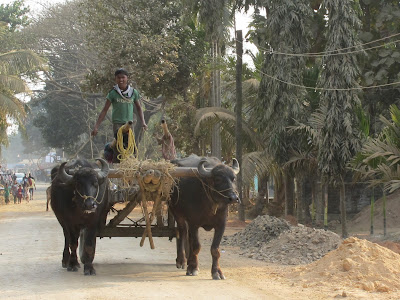
We left JFK for Dhaka, Bangladesh on the morning of January
3rd and arrived in the evening on January 4th. There is
an 11-hour time difference between Bangladesh and New York, so while you’re at
school I am eating dinner, writing to you and sleeping because it’s night here!
On the first day here, we drove from Dhaka to a place called Sitakund in the southeastern part of Bangladesh. The main bridge across the Meghna River is closed for construction so traffic was even worse than usual! We thought we would have to drive 50 miles north to reach another bridge, but our amazing driver called his friend and found out about a little-known ferryboat. It saved us many hours and we enjoyed our trip across the river.
The ferryboat is a barge that carries cars back and forth across the river. We saw lots of fishing boats on the river. The weather has been nice but some days there has been a lot of haze in the air.
We are in Sitakund because the rocks are folded, in what we geologists call an “anticline.” The sedimentary rocks here are made of layers of sand and mud that were originally deposited horizontal. Now those layers have been folded upwards due plate tectonic forces. The rock is crumpling up like a rug being pushed at from one end.
Our team at Sitakund: Jonathan, Suvro, Professor McHugh, Sojan, Fayaz, Professor Seeber, Dhiman and Ms. Ferguson.
I’m having a lot of fun hiking around this hill taking measurements. It is beautiful! We’re trying to determine the geometry of faults hidden below the surface here by mapping the folded rock. We also collect pieces of rock to study in the lab when we get home.

Soon Jonathan, Professor Seeber, Fayaz and I leave
Bangladesh for India, where we will be crossing more anticlines. Studying these
folds and the faults beneath them is very important for understanding how this
plate tectonic boundary works and determining the earthquake hazard.
This map shows the eastern border of Bangladesh in yellow.
The green stripes are anticlines (some have their names written on top). They
are green because they are hills with trees on top. We will be working on many
of the anticlines as we cross Tripura, India. The ground is being crumpled like
a rug, forming many folds.
I hope I will have internet access again soon and I look forward to reading your questions and comments!







































